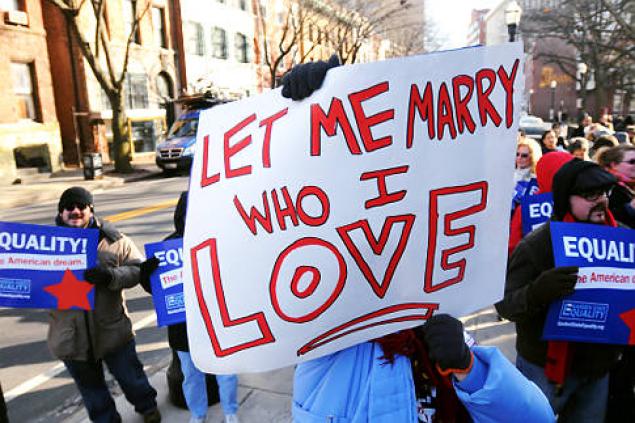Stanford’s Jane Schacter on Landmark Legislation to Protect Marriage Equality
On Tuesday, December 13, President Biden signed the Respect for Marriage Act, introducing new federal protections for same-sex and inter-racial marriages. Here, Stanford Law’s Jane Schacter, a scholar of constitutional law, discusses the new law, why it was needed after the Supreme Court’s landmark marriage protection decision, and if it will go far enough.

Why is this necessary after the Supreme Court’s landmark Obergefell v. Hodges decision?
The roots of this bill lie in last term’s Supreme Court decision in Dobbs v. Jackson Women’s Health Organization. There were two aspects of that case that set off alarm bells. First, in his concurrence, Justice Thomas explicitly called for Obergefell to be overruled. He attacked the legitimacy of the doctrine known as substantive due process, and argued that the same reasoning that he thought was flawed in Roe also afflicted Obergefell. Second, while Justice Alito’s majority opinion in Dobbs asserted that Obergefell was not in jeopardy, there were reasons to question those statements. The reasoning the majority used could well spell trouble for Obergefell and, indeed, Alito himself had dissented in Obergefell and made exactly the kinds of arguments he made in his Dobbs opinion. Thus, advocates were looking for ways to reinforce marriage equality in the event that Justice Thomas’ call to overrule Obergefell is answered by this Court.
How far will the federal legislation go in protecting marriage equality? Is same-sex marriage safe in the U.S. now?
The Act supplies important—but incomplete—protections. It does several things.
First, it repeals the Defense of Marriage Act, a 1996 law enacted by Congress at a time of widespread hostility to marriage equality. That act said that the federal government could not recognize same-sex marriages at all, even if states did; and also, that states had no obligation to recognize same-sex marriage performed in other states. Both of these restrictions represented a sharp break from the way marriage recognition had traditionally worked. The part of DOMA denying federal recognition to same-sex marriages that were valid in the state the couple lived in was struck down as unconstitutional in United States v. Windsor. But it is possible that Windsor could be overruled and DOMA reinstated if it were still on the books. Thus, repealing it offers protection against that scenario.
Second, it provides that the federal government will continue to recognize same-sex marriages that are valid under state law. That is the opposite of what DOMA had provided about federal recognition and it means that, even if Obergefell was overruled, same-sex couples would not be excluded from the many federal programs and laws that apply to married couples, such as tax, immigration, and social security laws.
Third, it uses the legislative power given to Congress under the Full Faith and Credit clause to require that states recognize a same-sex marriage that is valid under another state’s law. That clause says that “full faith and credit” shall be given in each state to the “acts” and “records” of other states, and Congress may “prescribe” the manner of enforcement. That is the authority Congress is using here. In the event Obergefell is at some point overruled and some states stop allowing same-sex couples to marry, couples, it seems, could go to another state to marry, and be recognized as such in their home state. It would protect same-sex couples validly married in the past or in states that chose to continue allowing same-sex marriage even if Obergefell was overruled.
Those are three important sources of protection.

What does the law not do?
What the law does not do, however, is impose on states a duty to allow same-sex couples to marry if Obergefell is overruled.
What happens if the Supreme Court revisits Obergefell?
I would guess that, if Obergefell is at some point overruled, some states would stop marrying same-sex couples. And opponents of same-sex marriage would then try to challenge the portion of the Respect for Marriage Act that requires all states to recognize same-sex marriages performed in another state. That would go back to the Full Faith & Credit clause. The objection would probably be framed in terms of federalism. I do not think that argument would be a strong one, but, as we have seen, the current Supreme Court can definitely be aggressive in moving the law in the direction it prefers.
Is there anything else you’d like to add?
It is striking that, in about a generation, Congress has come full circle in its attitudes and policy on same-sex marriage. DOMA passed by an overwhelming margin in 1996, and the Respect for Marriage Act, while not having a margin that commanding, had considerable Republican support (with some of that support coming after exemptions for religious institutions were included in the bill). In a larger sense, the degree of bipartisan support reflects a major shift in public opinion on marriage equality. Polls suggest that a supermajority of the public now approves of same-sex marriage. At the same time, while it is tempting to say that anti-LGBTQ attitudes must therefore be a thing of the past, that is far from true. We are witnessing an eruption of anti-LGBTQ bias and even violence around the country, especially targeted against transgender and other gender non-conforming people. Greater legal protections are still sorely needed in many areas.
